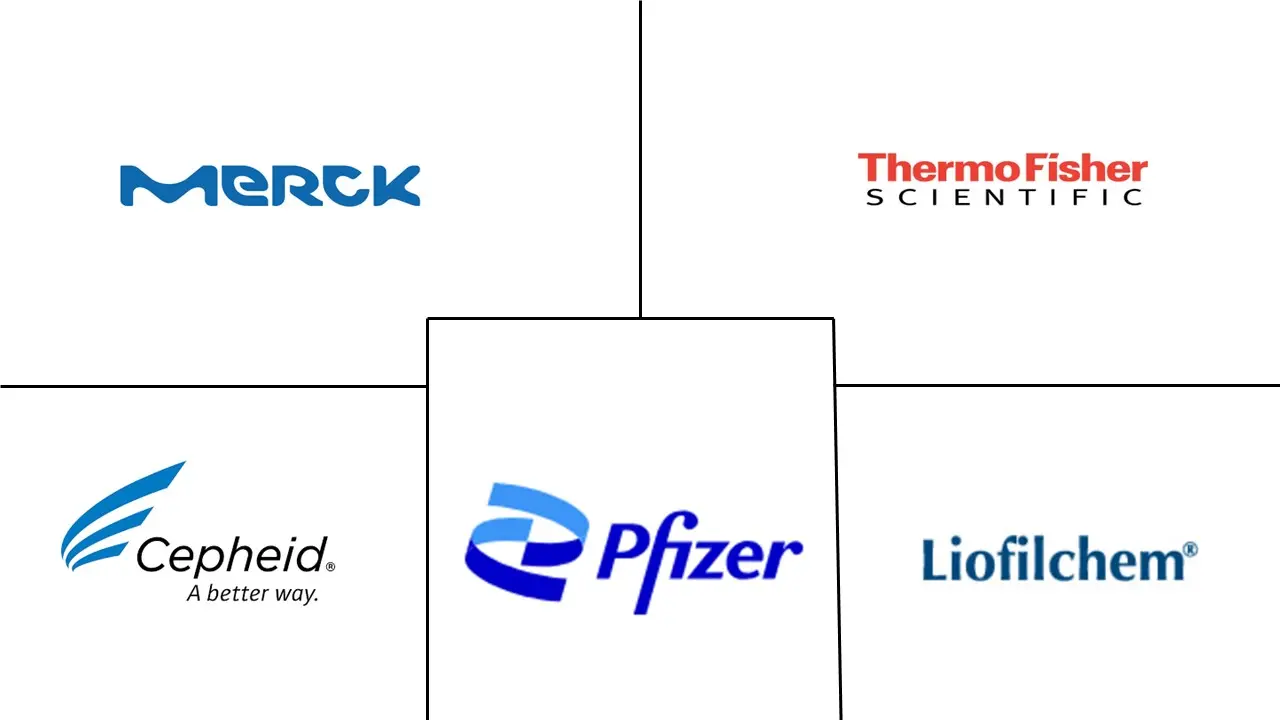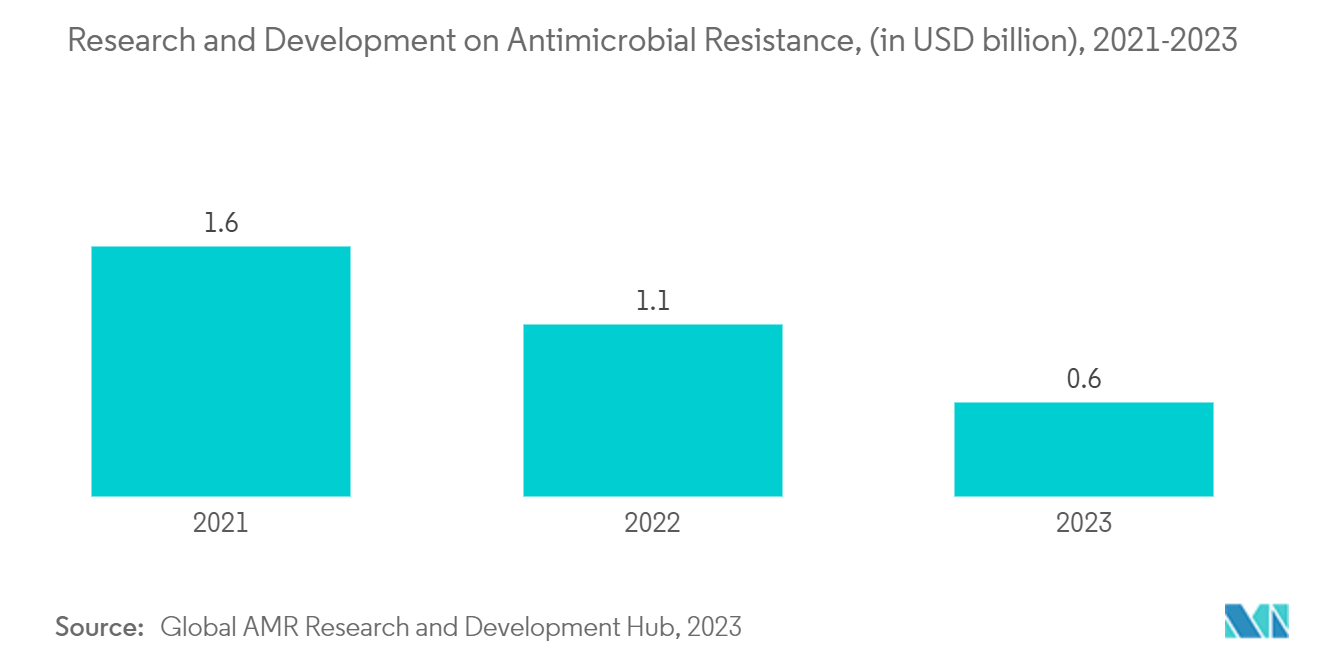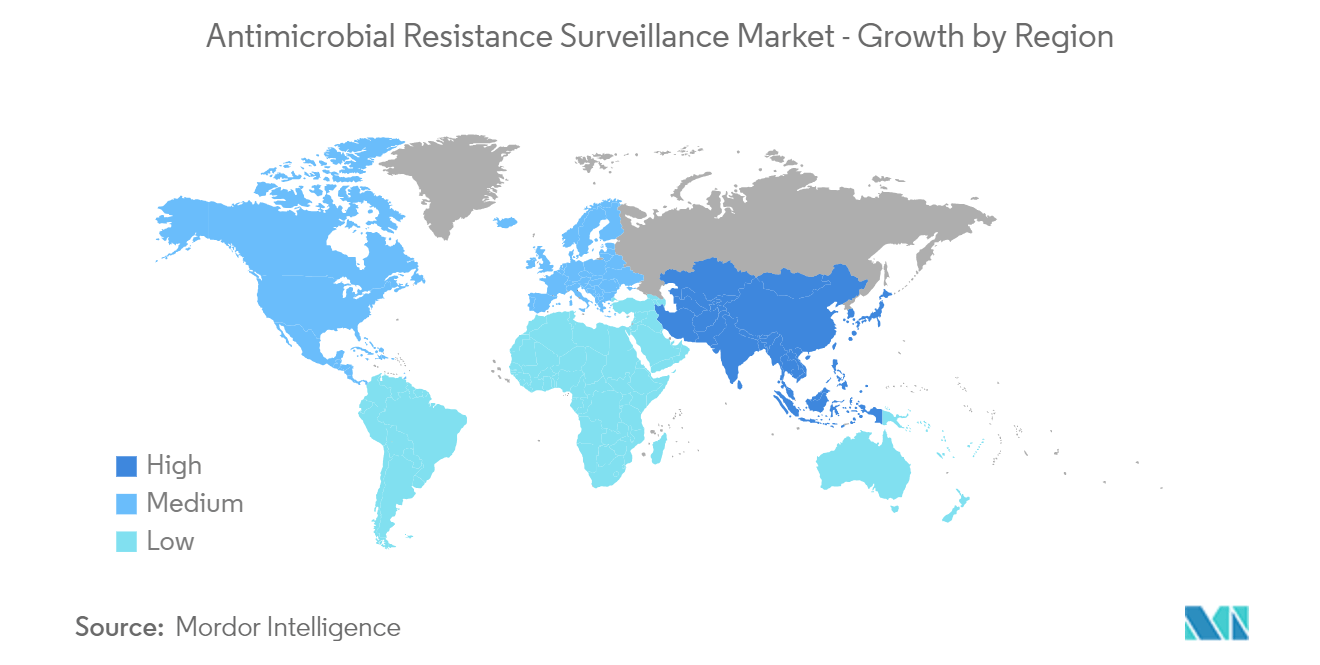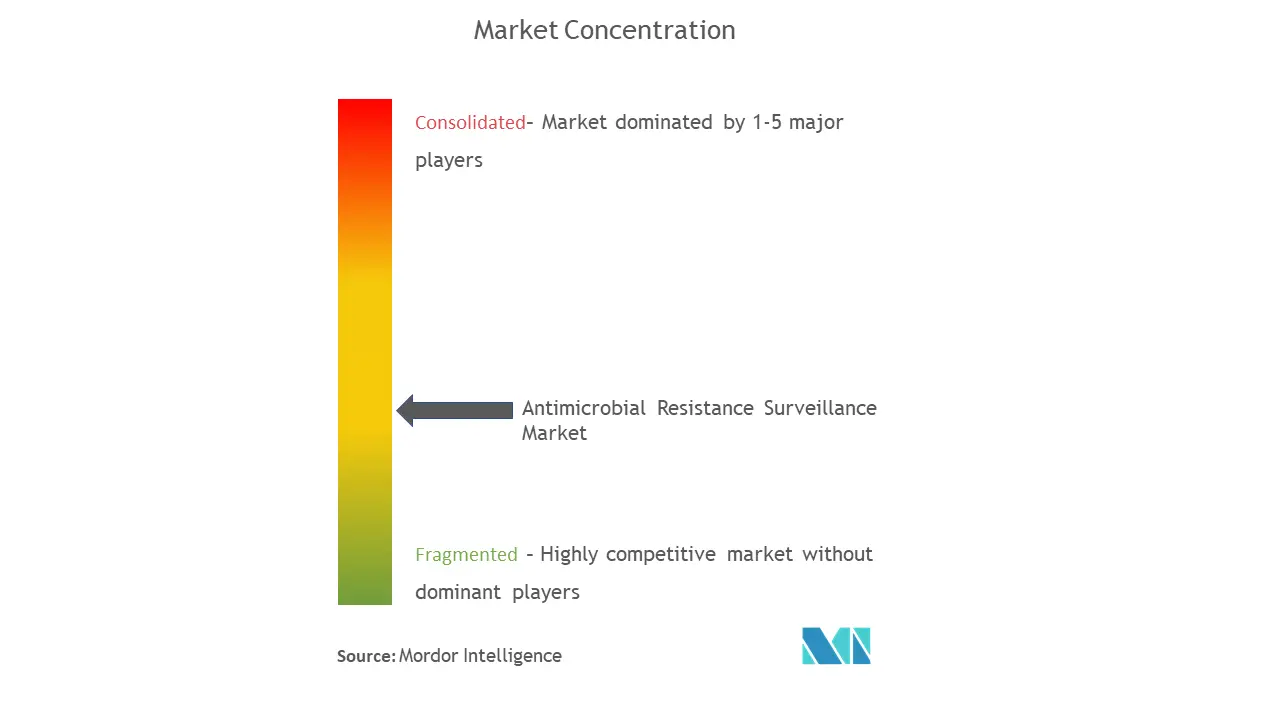Antimicrobial Resistance Surveillance Market Size

| Study Period | 2019-2029 |
| Market Size (2024) | USD 5.90 Billion |
| Market Size (2029) | USD 7.80 Billion |
| CAGR (2024 - 2029) | 5.70 % |
| Fastest Growing Market | Asia Pacific |
| Largest Market | North America |
Major Players
*Disclaimer: Major Players sorted in no particular order |
Antimicrobial Resistance Surveillance Market Analysis
The Antimicrobial Resistance Surveillance Market size is estimated at USD 5.90 billion in 2024, and is expected to reach USD 7.80 billion by 2029, growing at a CAGR of 5.70% during the forecast period (2024-2029).
The emergence of the COVID-19 pandemic had a mixed impact on the antimicrobial resistance surveillance market. The market was impacted during the pandemic owing to the overload of healthcare services, and most diagnostic labs diverted their complete focus to COVID-19 tests, which led to a reduction in the identification and tracking of antimicrobial-resistant bacteria during the pandemic period. According to the World Health Organization (WHO) Global Antimicrobial Resistance and Use Surveillance System (GLASS) Report 2022, COVID-19 significantly impacted antimicrobial surveillance during the first wave of the pandemic. Most countries that contribute antimicrobial resistance surveillance data to the WHO GLASS database cannot provide data during the peak stage of the pandemic. However, according to the same report, many countries have increased their laboratory capabilities and other antimicrobial surveillance system-strengthening efforts post-pandemic. This is expected to accelerate the antimicrobial resistance surveillance market during the forecasted period.
The major factors driving the market are the rising prevalence of infections caused by drug-resistant microbes, rising initiatives by governments to tackle infectious diseases, and emerging multi-drug resistance due to drug abuse. The WHO has declared antimicrobial resistance as a major threat to humanity. According to The European Centre for Disease Prevention and Control (ECDC) 2023 Report, each year, more than 670,000 infections occur in the European Union region due to bacteria resistant to antibiotics. This infection outbreak is majorly due to overuse or misuse of antibiotics. Furthermore, according to the Organization for Economic Cooperation and Development (OECD) 2023 data, the European Union spends 1.1 billion every year to combat antimicrobial Resistance infections (AMR). To reduce misuse and overuse of antimicrobial agents’ proper surveillance of AMR is needed to collect up-to-date information which helps doctors and patients make informed decisions about AMR treatment options; hence, WHO introduced the Global Antimicrobial Resistance and Use Surveillance System (GLASS), which collects antimicrobial resistance microbes’ data from 190 countries across the world every year. Thus, increasing the prevalence rate of antimicrobial resistance infections and accelerated surveillance to control AMR efforts of WHO to combat antimicrobial resistance microbes are expected to drive the antimicrobial resistance surveillance market.
Moreover, rising initiatives by governments to tackle infectious diseases will likely accelerate the market. Different nations across the world have taken initiatives to control the complex problem of antimicrobial resistance (AMR) by enhancing surveillance measures, promoting research and development activities, and collaborative actions to control antimicrobial resistance agents. For instance, the United States has launched the National Action Plan for Combating Antibiotic-Resistant Bacteria (CARB), 2020-2025. This initiative by the government will focus on five objectives: increasing stringing surveillance is one major objective to control the prevalence rate and mortality rate due to antimicrobial resistance infections. In addition, Asian countries like India also launched a Nation Action Plan (NAP) for antimicrobial resistance, which also focuses on the surveillance of antibiotic-resistant microbes. Hence, collective efforts of governments are expected to accelerate the antimicrobial resistance surveillance market.
Furthermore, the emergence of multi-drug resistance due to drug abuse is leading to an emergency crisis. There are many infecting agents (e.g., bacteria, fungi, viruses, and parasites) that can cause Multi-Drug Resistance such microbes are known as ‘superbugs.’ The major cause of MDR is overuse of OTC antibiotics and inadequate sanitary conditions maintenance. For Instance, According to Springer Nature Report 2023, the prevalence rate of MDR is 450,000 in 2021, which increased from 430,000 cases from the previous year. Hence, the emergence of multi-drug resistance is expected to lead to high surveillance efforts, which will likely drive the Antimicrobial Resistance Surveillance Market.
However, the higher cost of antimicrobial resistance surveillance systems and kits will likely restrain the growth of the antimicrobial resistance surveillance market.
Antimicrobial Resistance Surveillance Market Trends
The Clinical Diagnostics Under Application Segment is Expected to Hold a Significant Share in the Market
Clinical diagnostics occupy a significant market share due to the increased prevalence rate of antimicrobial resistance microbial infections and the urgent need to improve patient outcomes for those suffering from antimicrobial infections like ESKAPE (Enterococcus faecium, Staphylococcus aureus, Klebsiella pneumoniae, Acinetobacter baumannii, Pseudomonas aeruginosa, and Enterobacter species) because they represent the great threat to humans. In addition, the government's initiatives to improve clinical diagnostics centers working capabilities are also expected to drive the market. For example, according to the Department of Finance Canada Report 2022, the federal government introduced Bill C-17, which was to provide 2 billion (CAD) to different provinces and territories of the country to improve clinical diagnostic activities to control various diseases like infections caused by drug-resistant microbes. Additionally, in 2021, 25 European Union countries also launched national action plans to tackle antimicrobial resistance by investing 1.4 billion (EUR) to support ongoing surveillance of AMR through enhanced laboratory network capacity across the EU region.
Therefore, the higher prevalence rate of antimicrobial resistance infection, the urgent need to improve patient outcomes, and government investments are expected to boost the clinical diagnostic segment, which is estimated to witness significant growth over the forecast period.

North America is Expected to Dominate the Antimicrobial Resistance Surveillance Market
North America is expected to dominate the market owing to factors such as high awareness and prevalence rate of antimicrobial resistance to infectious diseases, government initiatives in the region to combat antibiotic resistance, and the presence of key market players in the region. According to the Centers for Disease Control and Prevention (CDC) database 2023, in the United States, more than 2.8 million antimicrobial-resistant infections (ARI) occur every year. To combat the prevalence rate of ARI, the United States government has invested 197 million (USD) in 2023. According to the CDC, these investments are expected to be used to develop preventive solutions and effective diagnosis and surveillance of antibiotic-resistant infections in the CDC’s Antimicrobial Resistance Laboratory Network networks (AR Lab Network). These cutting-edge laboratory facilities rapidly detect and store data about antimicrobial resistance, which will likely help doctors make informed decisions about the treatment.
Therefore, owing to the high prevalence rate of antimicrobial resistance microbial infections, increased investments to fight ARI by establishing new laboratory facilities are expected to drive the market in the North American region.

Antimicrobial Resistance Surveillance Industry Overview
The antimicrobial resistance surveillance market is moderately consolidated and competitive due to the presence of many players. The market's major players are concentrating on joint ventures, strategic alliances, introducing new products, and geographic growth into developing and economically advantageous areas. Some of the major players include Thermo Fisher Scientific, Pfizer Inc., Cepheid, Accelerate Diagnostics, In, Liofilchem S.r.l., Becton Dickinson and Company, Biomerieux, Bruker, Merck KgaA, Bio-Rad Laboratories, Inc., Qiagen, SyntBioLab INC, Sysmex Inostics, Guardant Health, Inc, Exact Sciences Corporation.
Antimicrobial Resistance Surveillance Market Leaders
-
Pfizer Inc.
-
Merck KgaA
-
Thermo Fisher Scientific
-
Cepheid
-
Liofilchem S.r.l.
*Disclaimer: Major Players sorted in no particular order

Antimicrobial Resistance Surveillance Market News
January 2022: Element Materials Technology, a leading provider of Testing, Inspection, and Certification (TIC) services on a wide range of products acquired from JMI Laboratories, offered microbiology and molecular testing services to assist in the development of new antimicrobials and clinical trial support. The acquisition was a part of Element’s broader strategic shift to increase its global presence in life sciences.
July 2022: DiaSorin S.p.A., a lab diagnostics provider specializing in the immunodiagnostics and molecular diagnostics segments, launched the LIAISON MeMed BV test, which helped physicians differentiate between viral and bacterial infection. The availability of this test provided a valuable tool in the growing global threat posed by antimicrobial resistance (AMR).
Antimicrobial Resistance Surveillance Market Report - Table of Contents
1. INTRODUCTION
- 1.1 Study Assumptions and Market Definition
- 1.2 Scope of the Study
2. RESEARCH METHODOLOGY
3. EXECUTIVE SUMMARY
4. MARKET DYNAMICS
- 4.1 Market Overview
-
4.2 Market Drivers
- 4.2.1 Rising Prevalence of Infections Caused by Drug-resistance Microbes
- 4.2.2 Rising Initiatives by Governments to Tackle Infectious Diseases
- 4.2.3 Emerging of Multi-Drug Resistance Due to Drug Abuse
-
4.3 Market Restraints
- 4.3.1 Higher Costs of Antimicrobial Resistance Surveillance systems and kits
-
4.4 Porter's Five Forces Analysis
- 4.4.1 Bargaining Power of Suppliers
- 4.4.2 Bargaining Power of Buyers/Consumers
- 4.4.3 Threat of New Entrants
- 4.4.4 Threat of Substitute Products
- 4.4.5 Intensity of Competitive Rivalry
5. MARKET SEGMENTATION (Market Size by Value-USD)
-
5.1 By Solution
- 5.1.1 Kits
- 5.1.2 System
- 5.1.3 Surveillance Software
- 5.1.4 Surveillance Service
-
5.2 By Application
- 5.2.1 Clinical Diagnostics
- 5.2.2 Public Health Surveillance
- 5.2.3 Other Applications
-
5.3 By End-User
- 5.3.1 Hospitals and Clinics
- 5.3.2 Diagnostic Centers
- 5.3.3 Other End-Users
-
5.4 Geography
- 5.4.1 North America
- 5.4.1.1 United States
- 5.4.1.2 Canada
- 5.4.1.3 Mexico
- 5.4.2 Europe
- 5.4.2.1 Germany
- 5.4.2.2 United Kingdom
- 5.4.2.3 France
- 5.4.2.4 Italy
- 5.4.2.5 Spain
- 5.4.2.6 Rest of Europe
- 5.4.3 Asia-Pacific
- 5.4.3.1 China
- 5.4.3.2 Japan
- 5.4.3.3 India
- 5.4.3.4 Australia
- 5.4.3.5 South Korea
- 5.4.3.6 Rest of Asia-Pacific
- 5.4.4 Middle East and Africa
- 5.4.4.1 GCC
- 5.4.4.2 South Africa
- 5.4.4.3 Rest of Middle East and Africa
- 5.4.5 South America
- 5.4.5.1 Brazil
- 5.4.5.2 Argentina
- 5.4.5.3 Rest of South America
6. COMPETITIVE LANDSCAPE
-
6.1 Company Profiles
- 6.1.1 DiaSorin S.p.A.
- 6.1.2 Thermo Fisher Scientific
- 6.1.3 Pfizer Inc.
- 6.1.4 Cepheid
- 6.1.5 Accelerate Diagnostics, In
- 6.1.6 Liofilchem S.r.l.
- 6.1.7 Becton Dickinson and Company
- 6.1.8 Biomerieux
- 6.1.9 Bruker
- 6.1.10 SyntBioLab INC.
- 6.1.11 Merck KgaA
- 6.1.12 Bio-Rad
- 6.1.13 Qiagen
- *List Not Exhaustive
7. MARKET OPPORTUNITIES AND FUTURE TRENDS
** Subject To AvailablityAntimicrobial Resistance Surveillance Industry Segmentation
As per the scope of the report, antimicrobial resistance surveillance refers to the collection and analysis of antimicrobial resistance microbes’ data for the detection and monitoring of different infections caused by these agents.
The antimicrobial resistance surveillance market is segmented by solution (kits, systems, surveillance software, and surveillance services), application (clinical diagnostics, public health surveillance, and other applications), end user (hospitals and clinics, diagnostic centers, and other end-users), and geography (North America, Europe, Asia-Pacific, the Middle East and Africa, and South America).
The report offers the value (in USD) for the above segments.
The market report also covers the estimated market sizes and trends for 17 different countries across major regions globally.
| By Solution | Kits | |
| System | ||
| Surveillance Software | ||
| Surveillance Service | ||
| By Application | Clinical Diagnostics | |
| Public Health Surveillance | ||
| Other Applications | ||
| By End-User | Hospitals and Clinics | |
| Diagnostic Centers | ||
| Other End-Users | ||
| Geography | North America | United States |
| Canada | ||
| Mexico | ||
| Geography | Europe | Germany |
| United Kingdom | ||
| France | ||
| Italy | ||
| Spain | ||
| Rest of Europe | ||
| Geography | Asia-Pacific | China |
| Japan | ||
| India | ||
| Australia | ||
| South Korea | ||
| Rest of Asia-Pacific | ||
| Geography | Middle East and Africa | GCC |
| South Africa | ||
| Rest of Middle East and Africa | ||
| Geography | South America | Brazil |
| Argentina | ||
| Rest of South America |
Antimicrobial Resistance Surveillance Market Research FAQs
How big is the Antimicrobial Resistance Surveillance Market?
The Antimicrobial Resistance Surveillance Market size is expected to reach USD 5.90 billion in 2024 and grow at a CAGR of 5.70% to reach USD 7.80 billion by 2029.
What is the current Antimicrobial Resistance Surveillance Market size?
In 2024, the Antimicrobial Resistance Surveillance Market size is expected to reach USD 5.90 billion.
Who are the key players in Antimicrobial Resistance Surveillance Market?
Pfizer Inc., Merck KgaA, Thermo Fisher Scientific, Cepheid and Liofilchem S.r.l. are the major companies operating in the Antimicrobial Resistance Surveillance Market.
Which is the fastest growing region in Antimicrobial Resistance Surveillance Market?
Asia Pacific is estimated to grow at the highest CAGR over the forecast period (2024-2029).
Which region has the biggest share in Antimicrobial Resistance Surveillance Market?
In 2024, the North America accounts for the largest market share in Antimicrobial Resistance Surveillance Market.
What years does this Antimicrobial Resistance Surveillance Market cover, and what was the market size in 2023?
In 2023, the Antimicrobial Resistance Surveillance Market size was estimated at USD 5.56 billion. The report covers the Antimicrobial Resistance Surveillance Market historical market size for years: 2019, 2020, 2021, 2022 and 2023. The report also forecasts the Antimicrobial Resistance Surveillance Market size for years: 2024, 2025, 2026, 2027, 2028 and 2029.
Antimicrobial Resistance Surveillance Industry Report
Statistics for the 2024 Antimicrobial Resistance Surveillance market share, size and revenue growth rate, created by Mordor Intelligence™ Industry Reports. Antimicrobial Resistance Surveillance analysis includes a market forecast outlook to for 2024 to 2029 and historical overview. Get a sample of this industry analysis as a free report PDF download.



